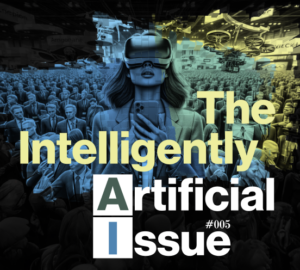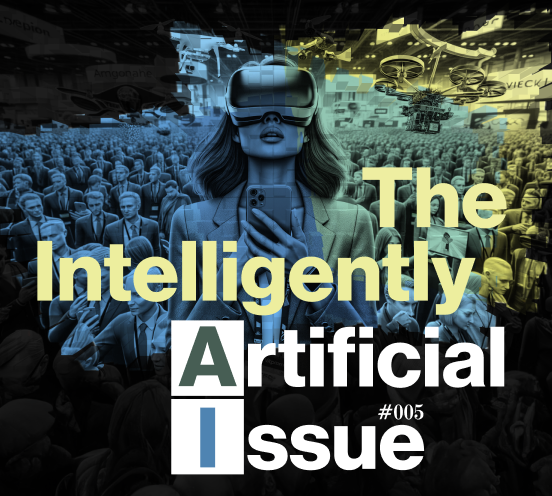Are businesses
even asking the
right AI questions?
The AI landscape is changing quickly. So quickly that as soon as we think we’re starting to understand its power, there seems to be another giant leap forward. It doesn’t help that we are surrounded by fake AI experts who claim to have all the answers.
Truthfully, given all the unknowns, there are more questions than answers today. Each question has a cascading impact on other questions and seems to only bring a series of new questions. The answers right now are only guesses, predictions at best based on hopefully thoughtful reasoning, meant to provide a productive discourse that drives perspectives and decision-making. Any verifiable answers will only reveal themselves tomorrow.
From the editor: The takes below are based on a projection toward the end of the 2020s and are intentionally opinionated and incomplete. We aim to go deeper on each question in future content and at future events, including via ON_CES.
01
What is the future of
SaaS and BI tools?
Today, businesses use siloed tech with a questionable data strategy.
Tomorrow, the SaaS ecosystem will consolidate into very few companies.
Companies of all sizes currently rely on a fragmented ecosystem of technologies. BI tools are siloed not due to the tech itself, but due to a lack of data strategy and organizational structure. People own different elements of the chain (separate teams own social, the web, and so on). This has given discreet software companies the opportunity to solve specific use cases.
The global SaaS market is projected to grow from $273.55 billion in 2023 to $908.21 billion by 2030. In the past decade, marketing software alone has grown from 150 tools in 2011 to 11,038 tools in 2023. There is a high likelihood that the ecosystem could consolidate, eliminating the opportunity and the role of discrete software systems.

One of the core advantages of AI is its unique ability to assess, simplify, and make sense of large amounts of information. By making sense of data, AI can communicate more easily and effectively given the simplified semantic interfaces, a previous pain point for large consolidated systems.
Since the advent of ChatGPT, we’ve seen a gold rush of companies using LLMs to change the way we process, communicate, and execute decisions. This technology is evolving so quickly that we could see it swallow the companies being built upon it. This should lead to fewer, but better, SaaS and BI tools, bringing up other questions about how companies differentiate themselves and the role of humans.
02
How do we make
AI safe for businesses
to use?
Today, businesses are worried about protecting their IP and potential copyright lawsuits, moral issues, and reputational problems.
Tomorrow, businesses will rely on new legal and procedural precedents to use AI tools liberally.
There is legal precedent, there is enforcement, and there is public opinion.
Firstly, legal precedent (including regulation and policy) will naturally unfold and become clearer. One can make some guesses and predictions here, but ultimately, for competition to thrive, the laws will have to allow for some liberal use of the technologies. This can and will be argued, but it’s a fool’s game to think you can regulate away technological progress.
Secondly, as legal precedents are set, challenges will surface around identification and consequences for any wrongdoing. These will need to be policed at some level and possibly even enforced by code. Could smart contracts on the blockchain protect and enforce IP rights? Additionally, industry collectives like the RIAA, which in the early 2000s protected music IP, may form to make examples of companies and individuals breaching legal boundaries. Alternatively, AI tool use could become so common that courts won’t even consider lawsuits regarding copyright, trademarks, and reputation (although this is hard to imagine).
Lastly, public opinion could shape business use cases. Is there a risk of bias? Does a brand face risks when it represents something inaccurately or inappropriately using AI that it didn’t control? It’s hard enough to manage scaled public relations in a world where an executive is one tweet away from being fired or losing trillions in market value. We are entering a world in which ephemeral content is generated in seconds. Brands may struggle to keep up. Organizations will need to manage AI health just like they do cybersecurity.
03
How do we make
AI safe for people?
Today, businesses own people’s personal data.
Tomorrow, businesses will offer identity protection technology.
Regular audits of public companies not only verify the accuracy and legality of their financial records but also assess whether an organization has adequate controls and processes in place to mitigate potential liabilities. Future regulations may require audits on AI tools to make sure companies are operating legally, including via people controls and by reviewing code.
The government or businesses may also offer trust systems that let people authenticate their identities to interact as themselves with public and private sector services.
Alternatively, people may try to circumvent any potential censorship or gating by masking their identities.
04
Is your
competitive landscape
being
disrupted?
Today, businesses try to understand their direct competitors.
Tomorrow, businesses will be able to analyze their indirect competitors and existential threats.
AI-powered analysis tools could soon ingest data about every market globally and make connections between businesses, causing entire industries to disappear. Businesses could leverage AI to be predictive and anticipatory, uncovering opportunities that disrupt categories they never considered entering. Super apps that can do everything are a real threat.

Alternatively, categorical disruption may not happen because businesses will train AI tools on proprietary data to maintain their competitive advantage. The role of a brand will thus still matter because companies that are more focused on designing a specific user experience will be able to continue to differentiate themselves by providing unique value, while non-focused competitors won’t.
05
What is the future of
customer experience landscapes?
Today, businesses rely on traditional personalized targeting, information architecture, and rigid user flows.
Tomorrow, businesses will rely on anticipatory semantic and potential ephemeral experiences to target behaviors.
Is the interface that consists of a simple prompt text box with a response field here to stay? Or, will interfaces across various devices foresee what humans want, need, and desire, showing only the information that is relevant to users, when and where it’s required? Instead of you prompting the interface, maybe the interface will prompt you.
AI models may be able to help companies better understand their customers, viewing each one as a whole person and generating for them a more efficient, frictionless, and possibly ephemeral, experience in real time. This could include entertainment, marketing generated to pique interest, and interface elements like CTAs and drop-downs built in real time.

Alternatively, humans may not want generated content or experiences and will opt for more directed, but still personalized, user experiences.
06
What is the future of
branding?
Today, businesses build brand identities based on static logos and brand books.
Tomorrow, businesses will build brands whose attributes can be generated on the fly based on an identity that more closely resembles a human.
Brands in the future will have to act in real time. AI will be on the front lines across touchpoints, communicating dynamically with customers. The way a brand communicates at those digital moments will largely represent the whole brand.
It’s also conceivable that ad units will evolve into more dynamic product placements or other unique constructs as the world pivots to where audiences are engaging. The interactions will seemingly be more human and therefore branding will need to be more lifelike, built into a framework that can make its own decisions.
Conversely, brands could lose meaning because every business can just mirror back to people what they want, in real time.
07
Does
authenticity matter?
Today, a brand brings authenticity.
Tomorrow, ownership will be more important than authenticity.
Companies are grappling with when and how to be transparent about their use of AI tools. As AI becomes the baseline, companies that own everything they do will stand out. They may be able to build authenticity by unapologetically using AI to offer their customers what they need and want.
The key attribute will be ownership. Whether a piece of content is a deepfake won’t matter if you own the rights to use a given name, image, or likeness. How you create the content won’t be controversial. Ownership will be a core defining factor of both uniqueness and differentiation for a brand.
One could argue that a brand will be even more valuable in the future as a lot of the market consolidates and aggregators become makers. That said, ownership and uniqueness may become harder to achieve, and unique rights might become more expensive.
08
Should a business
invest quickly or slowly
in AI?
Today, businesses either invest too slowly and leave themselves open to disruption or too quickly and spend wasted capital.
Tomorrow, the landscape will be defined by where the opportunity and need for investment is.
Businesses recognize the importance of AI but often overspend due to a fear of falling behind. Despite the influx of ever-improving tools, there’s a noticeable redundancy in these so-called “innovative” ideas, hinting at future industry consolidation. On the flip side, inaction poses its own dangers, potentially leading to business stagnation and loss of a competitive edge.
Businesses should do two things immediately: build and invest in a data strategy and create a culture of safe experimentation with AI tools. The barrier to entry is surprisingly low.
09
What will
define creativity
in the
future?
Today, businesses define creativity as a skill.
Tomorrow, businesses will define creativity only in the way humans think, not what humans can do.
The advent of generative AI could fundamentally transform how we value skills, pivoting from the traditional execution of skills to an emphasis on analytical and creative thinking. The necessity for manual skills in drawing, writing, or designing may diminish, as generative AI democratizes these abilities.
Furthermore, the reliance on human intuition for decision-making could shift toward AI-driven insights and analyses, processed rapidly and impartially. This change might render prompt engineers obsolete, as AI chatbots take on the burden of generating complex prompts.
This shift could lead to a scenario where digital content and experiences are ephemeral, created spontaneously by AI, potentially reducing the significance of human creativity in producing “things." Creativity might then be seen as a common resource, easily replicable and valued less.
Conversely, the future of business creativity might lie in the ability to innovate without relying on data or existing knowledge. Human distinctiveness could emerge through the generation of novel ideas, fueled by uniquely human emotions, such as passion and envy. In this scenario, genuine creativity could become rarer, yet significantly more treasured.
Final
Thoughts
AI is going to shuffle the deck of what companies do and provide, changing the competitive landscape and ultimately the workforce. Some changes will be obvious, like new forms of creative workforces, but others won’t be, like new types of departments, roles, and C-level officers around ethics, identity, and customer safety.


